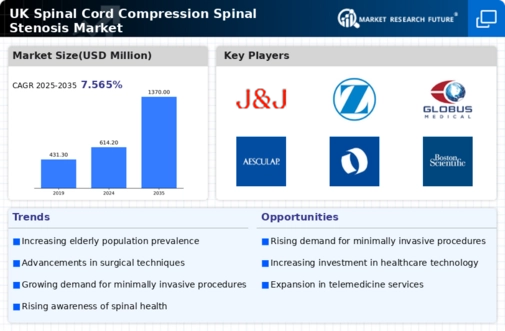Rising Awareness and Education
Growing awareness and education regarding spinal health are pivotal in shaping the spinal cord-compression-spinal-stenosis market. Campaigns aimed at educating the public about the symptoms and treatment options for spinal stenosis are becoming more prevalent. This increased awareness is likely to lead to earlier diagnosis and intervention, which can improve patient outcomes. Furthermore, healthcare professionals are receiving enhanced training on the latest treatment protocols, which may contribute to a more informed patient population. As awareness continues to rise, the demand for services and products related to spinal stenosis is expected to grow, positively impacting the spinal cord-compression-spinal-stenosis market.
Increased Healthcare Expenditure
The rise in healthcare expenditure in the UK is a critical driver for the spinal cord-compression-spinal-stenosis market. With the National Health Service (NHS) allocating more funds towards spinal health, there is a growing emphasis on research and development of new treatment modalities. In 2025, healthcare spending is projected to reach £200 billion, with a portion dedicated to spinal disorders. This financial commitment is likely to foster innovation and improve access to advanced therapies for spinal stenosis. As a result, the spinal cord-compression-spinal-stenosis market may experience accelerated growth, driven by enhanced treatment options and increased patient access to care.
Advancements in Surgical Techniques
Innovations in surgical techniques are significantly influencing the spinal cord-compression-spinal-stenosis market. Minimally invasive procedures, such as endoscopic spine surgery, have gained traction due to their reduced recovery times and lower complication rates. Data suggests that these techniques can decrease hospital stays by up to 50%, which is appealing to both patients and healthcare providers. As surgeons become more adept at these advanced methods, the demand for surgical interventions in spinal stenosis is likely to increase. This shift towards less invasive options may lead to a broader acceptance of surgical treatments, thereby expanding the market and enhancing patient outcomes in the spinal cord-compression-spinal-stenosis market.
Rising Incidence of Spinal Disorders
The increasing prevalence of spinal disorders in the UK is a notable driver for the spinal cord-compression-spinal-stenosis market. Recent studies indicate that approximately 30% of adults over 50 experience some form of spinal stenosis, leading to heightened demand for effective treatment options. This trend is likely to escalate as the population ages, with projections suggesting that by 2030, the number of individuals affected could rise by 20%. Consequently, healthcare providers are focusing on innovative therapies and surgical interventions to address this growing issue, thereby stimulating market growth. The spinal cord-compression-spinal-stenosis market is expected to benefit from this rising incidence, as more patients seek medical attention and treatment solutions.
Technological Integration in Diagnostics
The integration of advanced technologies in diagnostic procedures is emerging as a significant driver for the spinal cord-compression-spinal-stenosis market. Innovations such as MRI and CT imaging have revolutionized the way spinal conditions are diagnosed, allowing for more accurate assessments. Enhanced imaging techniques can lead to earlier detection of spinal stenosis, which is crucial for effective treatment planning. As diagnostic capabilities improve, healthcare providers are likely to identify more cases of spinal cord compression, thereby increasing the patient population seeking treatment. This trend suggests a potential expansion of the spinal cord-compression-spinal-stenosis market as more individuals are diagnosed and treated.




















Leave a Comment